 W
WThe Amami thrush is a member of the thrush family Turdidae. It is endemic to the islands of Amami Ōshima and Kakeroma island in the northern Nansei Islands of Japan.
 W
WThe Apo sunbird is a species of bird in the sunbird family Nectariniidae. It is endemic to the island of Mindanao in the Philippines.
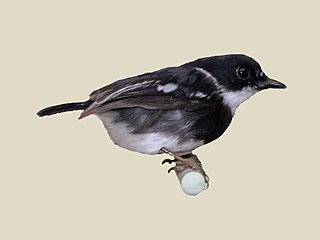 W
WThe Rwenzori batis is an endemic bird native to the Albertine Rift montane forests, where it inhabits altitudes of 1,340–3,300 m (4,400–10,830 ft).
 W
WThe coal-crested finch is a species of bird in the family Thraupidae. Though previously classified in the bunting and American sparrow family Emberizidae, molecular phylogenetic studies have shown that it is a member of the large tanager family Thraupidae. It is the only member of the genus Charitospiza.
 W
WDinelli's doradito is a species of bird in the family Tyrannidae. It is found in Argentina, Bolivia, and Paraguay. Its natural habitats are subtropical or tropical dry shrubland, subtropical or tropical dry lowland grassland, and swamps. It is threatened by habitat loss.
 W
WThe Gran Canaria blue chaffinch is a species of passerine bird in the finch family Fringillidae. It is endemic to Gran Canaria in Spain's Canary Islands.
 W
WThe great xenops is a furnariid bird, which is endemic to the Caatinga region of north-eastern Brazil. It is monotypic within the genus Megaxenops.
 W
WThe Guadeloupe parakeet might have been a species of parrot that was endemic to Guadeloupe.
 W
WThe hooded gnateater is a species of bird in the family Conopophagidae. It is endemic to northern Brazil.
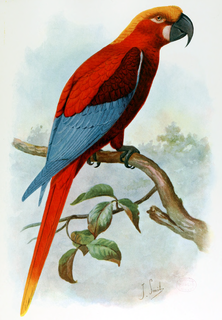 W
WThe Jamaican red macaw may have been a species of parrot in the family Psittacidae that lived on Jamaica, but its existence is hypothetical.
 W
WKemp's longbill is a species of Old World warbler in the family Macrosphenidae. It is found in Cameroon, Ivory Coast, Ghana, Guinea, Liberia, Nigeria, and Sierra Leone. Its natural habitat is subtropical or tropical moist lowland forests.
 W
WThe large-billed reed warbler is an Old World warbler in the genus Acrocephalus. The species has been dubbed as "the world's least known bird". It was known from a single specimen collected in India in 1867 and rediscovered in the wild in Thailand in 2006. The identity of the bird caught in Thailand was established by matching DNA sequences extracted from feathers; the bird was released. After the rediscovery in the wild a second specimen was discovered amid Acrocephalus dumetorum specimens in the collections of the Natural History Museum at Tring. A breeding area was found in Afghanistan in 2009 and studies in 2011 pointed to its breeding in Kazakhstan and Tajikistan. One bird was found in the Baikka Wetland in Srimangal, Bangladesh on 7 December 2011.
 W
WThe Lesser Antillean macaw or Guadeloupe macaw is a hypothetical extinct species of macaw that is thought to have been endemic to the Lesser Antillean island region of Guadeloupe. In spite of the absence of conserved specimens, many details about the Lesser Antillean macaw are known from several contemporary accounts, and the bird is the subject of some illustrations. Austin Hobart Clark described the species on the basis of these accounts in 1905. Due to the lack of physical remains, and the possibility that sightings were of macaws from the South American mainland, doubts have been raised about the existence of this species. A phalanx bone from the island of Marie-Galante confirmed the existence of a similar-sized macaw inhabiting the region prior to the arrival of humans and was correlated with the Lesser Antillean macaw in 2015. Later that year, historical sources distinguishing between the red macaws of Guadeloupe and the scarlet macaw of the mainland were identified, further supporting its validity.
 W
WThe lesser hoopoe-lark is a species of lark in the family Alaudidae. It is endemic to Somalia where its natural habitat is subtropical or tropical dry lowland grassland.
 W
WThe Maghreb owl is an owl of the earless owl genus, Strix. It occurs in northwestern Africa from Morocco to Tunisia and Mauritania. It was previously considered a subspecies of the tawny owl.
 W
WThe Malayan whistling thrush or Malaysian whistling-thrush is a species of bird in the family Muscicapidae. It is endemic to the Malay Peninsula. Due primarily to habitat loss, its population is thought to be in decline.
 W
WThe Martinique amazon is a hypothetical extinct species of Caribbean parrot in the family Psittacidae. It is not known from any material remains, but was said to be similar to the red-necked amazon from Dominica, the next major island to the north of Martinique. Natives are known to have traded extensively in parrots between the Antilles, and it seems that the Martinique population was in some way related to or even descended from A. arausiaca.
 W
WThe Martinique macaw or orange-bellied macaw is a hypothetical extinct species of macaw which may have been endemic to the Lesser Antillean island of Martinique, in the eastern Caribbean Sea. It was scientifically named by Walter Rothschild in 1905, based on a 1630s description of "blue and orange-yellow" macaws by Jacques Bouton. No other evidence of its existence is known, but it may have been identified in contemporary artwork. Some writers have suggested that the birds observed were actually blue-and-yellow macaws. The "red-tailed blue-and-yellow macaw", another species named by Rothschild in 1907 based on a 1658 account, is thought to be identical to the Martinique macaw, if either has ever existed.
 W
WNahan's partridge, also known as the Nahan's francolin, is a bird traditionally placed in the family Phasianidae. As suggested by its alternative name, it was formerly believed to be a francolin and placed either in Francolinus or Pternistis, but it is now known that its closest relative is the stone partridge and together may in fact be the only African representatives of the New World quails (Odontophoridae).
 W
WThe Obbia lark is a species of lark in the family Alaudidae. It is found in central Somalia, where it is endemic. Its natural habitat is sub-tropical or tropical dry shrubland.
 W
WThe pink-rumped rosefinch is a species of finch in the family Fringillidae.
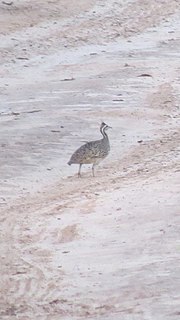 W
WThe quebracho crested tinamou is a species of tinamou found in dry forest habitats in Paraguay and northern Argentina in South America.
 W
WThe red-shouldered spinetail is a species of bird in the ovenbird family Furnariidae. It is endemic to the Caatinga region of north-eastern Brazil. It is threatened by habitat loss.
 W
WThe Rio de Janeiro antbird is a species of bird in the family Thamnophilidae. It is endemic to Brazil.
 W
WThe Rio Madeira stipplethroat, also called Madeira stipple-throated antwren, Madeira antwren or Rio Madeira antwren, is a species of bird in the family Thamnophilidae found in Brazil and Bolivia. Until 2014, it was considered a subspecies of the rufous-backed stipplethroat. The Rio Madeira stipplethroat has two subspecies:E. a. amazonica (von Ihering, 1905) - Brazil and Bolivia E. a. dentei Whitney, BM et al., 2013 - Brazil
 W
WThe rufous-headed tailorbird is a species of bird in the family Cettiidae. It is found only in the Philippines. Its natural habitats are subtropical or tropical moist lowland forest and subtropical or tropical moist montane forest.
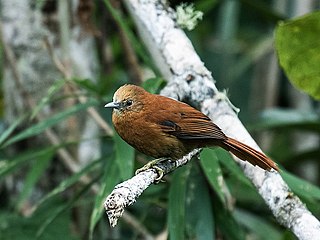 W
WThe russet-mantled softtail is a species of bird in the family Furnariidae. It is endemic to Peru.
 W
WThe sandstone shrikethrush is a species of bird in the family Pachycephalidae. It is endemic to Australia. Alternate names for the sandstone shrikethrush include the brown-breasted shrike-thrush and sandstone thrush.
 W
WThe slaty-backed jungle flycatcher is a species of birds in the Old World flycatcher family Muscicapidae. It is endemic to the Philippines. The specific epithet honours the British zoological collector Walter Goodfellow. Its natural habitat is subtropical or tropical moist montane forests. It is becoming rare due to habitat loss.
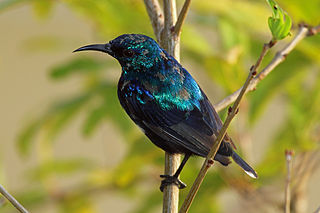 W
WThe Pemba sunbird is a species of bird in the sunbird family. It is endemic to Pemba Island, in Tanzania.
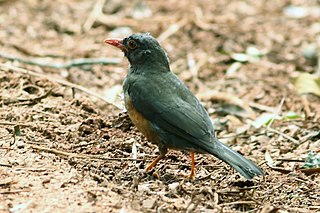 W
WThe Usambara thrush, also known as Roehl's thrush or Usambara olive thrush, is a species of thrush found in eastern Africa. Formerly, it was considered as a subspecies of the olive thrush, with which it is known to hybridize with, but is now recognised as a separate species.
 W
WThe unspotted saw-whet owl is a small owl. It is a resident breeder in the highlands of Central America from southern Mexico south to western Panama, mainly at altitudes above 2500 m. It has occasionally been considered conspecific with the northern saw-whet owl. There are currently no recognized subspecies.
 W
WThe white-throated grasswren is a species of bird in the family Maluridae. It is endemic to Australia.
 W
WThe Xingu scale-backed antbird is a species of antbird from the south-eastern Amazon in Brazil. Until 2011, it was usually included as a subspecies of the common scale-backed antbird. Its English name refers to the Xingu River. In addition to the nominate subspecies, it includes the subspecies W. v. nigrigula.